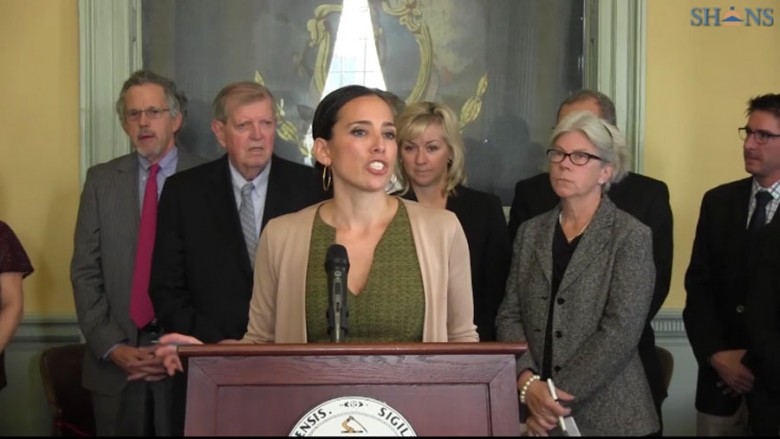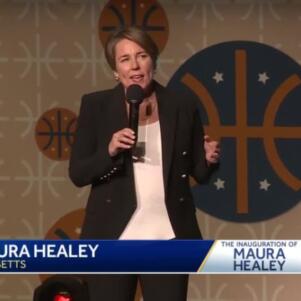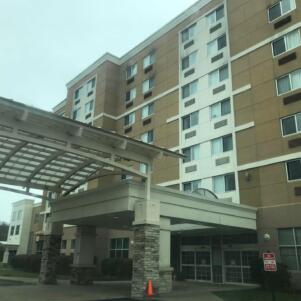Mass. K-12 budgets squeezed by insurance, SPED costs
By State House News Service | November 3, 2015, 6:13 EST
 Sen. Chang Diaz, flanked by members of the Foundation Budget Review Commission, release education funding report (State House News Service)
Sen. Chang Diaz, flanked by members of the Foundation Budget Review Commission, release education funding report (State House News Service) STATE HOUSE — High costs for employee health insurance and special education have reduced the resources school districts can invest in other areas, including extended learning time, books, technology, arts, and counseling, according to a report released Monday by a commission charged with evaluating the state’s school finance law.
The Foundation Budget Review Commission, established by legislation in 2014, called in its report for updates to how the state calculates the per pupil cost of delivering education in Massachusetts, saying that the current system’s starting point — known as the foundation budget — underestimates the cost of educating students by at least $1 billion per year.
“Districts today are really laboring under a formula and laboring under assumptions that are incorrect, and right now our investments really aren’t matching our expectations,” said Sen. Sonia Chang-Diaz, who led the commission along with Rep. Alice Peisch. “Nobody believes that we should lower our expectations, and so we need to up the speed when it comes to matching our investment.”
If put into place by the Legislature, the commission’s recommendations would represent the first major updates to the state’s education financing system since the landmark Education Reform Act of 1993.
The financing formulas contained in the 1993 law “proved fair guidances” for the most part, though the commission found the formula “radically out of whack” in special education and health insurance costs, said former Education Secretary Paul Reville, a commission member and one of the original architects of education reform act.
[Watch: Commission Remarks]
According to the report, school district spending on employee benefits throughout Massachusetts exceeds the foundation budget allotment by more than 140 percent. The commission recommends that the formula be changed to calculate insurance costs and inflation rates based on actual averages from the state’s Group Insurance Commission.
The foundation budget formula also “understates the number of in-district special education students and the cost of out-of-district special education,” the report found. Its authors recommended increasing the in-district enrollment rate and out-of-district cost rate to accurately reflect what districts are paying.
Peisch, who chairs the Legislature’s Education Committee with Chang-Diaz, said that school districts have no leeway to modify their fixed costs for special education or health insurance to spend on other priorities.
“As a result, money is being taken away from other areas that the foundation budget provides for in order to fund these components,” Peisch said. “With sufficient funding for these areas, millions of dollars across the commonwealth will be freed up to spend on the kinds of things that we know students need.”
The foundation budget establishes what each school district should spend annually per student, determined through a complex formula that Reville said was aimed at ensuring adequacy, equity and stability in school finance so all students could be educated to a high level.
“The Legislature has been understandably reluctant over the years to reopen discussion of what went into the spreadsheet,” Reville said. “There were only the most modest efforts at tinkering with the basic assumptions that went into calculating what would constitute adequacy, what we would need to provide.”
If the commission’s insurance and special education adjustments were adopted in full, the amount of Chapter 70 aid issued statewide would need to increase by nearly $432 million to $4.9 billion. If they were adopted partially with the intent of phasing in changes over four years, the increase would be nearly $96 million.
Noting that the state spends “north of $16 billion a year” in federal, state and local money on education, Elementary and Secondary Education Commissioner Mitchell Chester said he was interested not just in calling for greater investment, but in heeding the commission’s recommendations to ensure efficient and effective use of resources.
“When we go to the taxpayers and ask them to increase their investment in the commonwealth’s K-12 system, we need to be able to say to them that we’re doing the best that we can with the dollars that we have,” Chester said.
[Watch: Q&A With Commission]
The report says districts should be required to post plans online outlining how they plan to use funds allotted for English language learners and low-income students and then also publish the outcomes of those efforts.
The current funding formula does not fully reflect the extra costs and intensive work required to teach students who are learning English or come from low-income homes, the report says. It calls for funding increases that would allow districts to adopt a variety of strategies to address inequity and work to close achievement gaps, including extending the school day and reducing class size.
Commissioners wrote in their report that they wanted to build on the 1993 education reform law, praising the progress made since then in making high-quality education available to all students in Massachusetts.
“But reports from the field and the research community alike in recent years have suggested that the system is fiscally strained by the failure to substantively reconsider the adequacy of the foundation budget since 1993, and that the formula may need re-tooling to meet the needs of the 21st Century,” the report reads. “Moreover, 22 years after the advent of education reform, the challenge we have not yet achieved desired results on is to deliver quality consistently to all geographies and all demographic groups across our state.”
The commission said that work done since 1993 would be at risk if schools are hampered by an inadequate foundation budget.
Individual districts would also need to spend more to implement the report’s recommendations on health insurance and special education. Fully implementing them would call for an additional nearly $136.6 million total in required district contributions statewide, though the commission noted that more than 160 school districts already spend more than they are required to.
“We recognize that recommendations of this scope and size will need to be phased in to be affordable,” the commission wrote in its report, urging the Legislature to act with “a keen sense of urgency” in addressing funding gaps.
The commission was not tasked with identifying funding sources for the budget formula upgrades it is recommending. Chang-Diaz said finding the money will be among the Legislature’s next steps in acting on the report.
For the full report click here.
— Written by Katie Lannan
Copyright State House News Service










